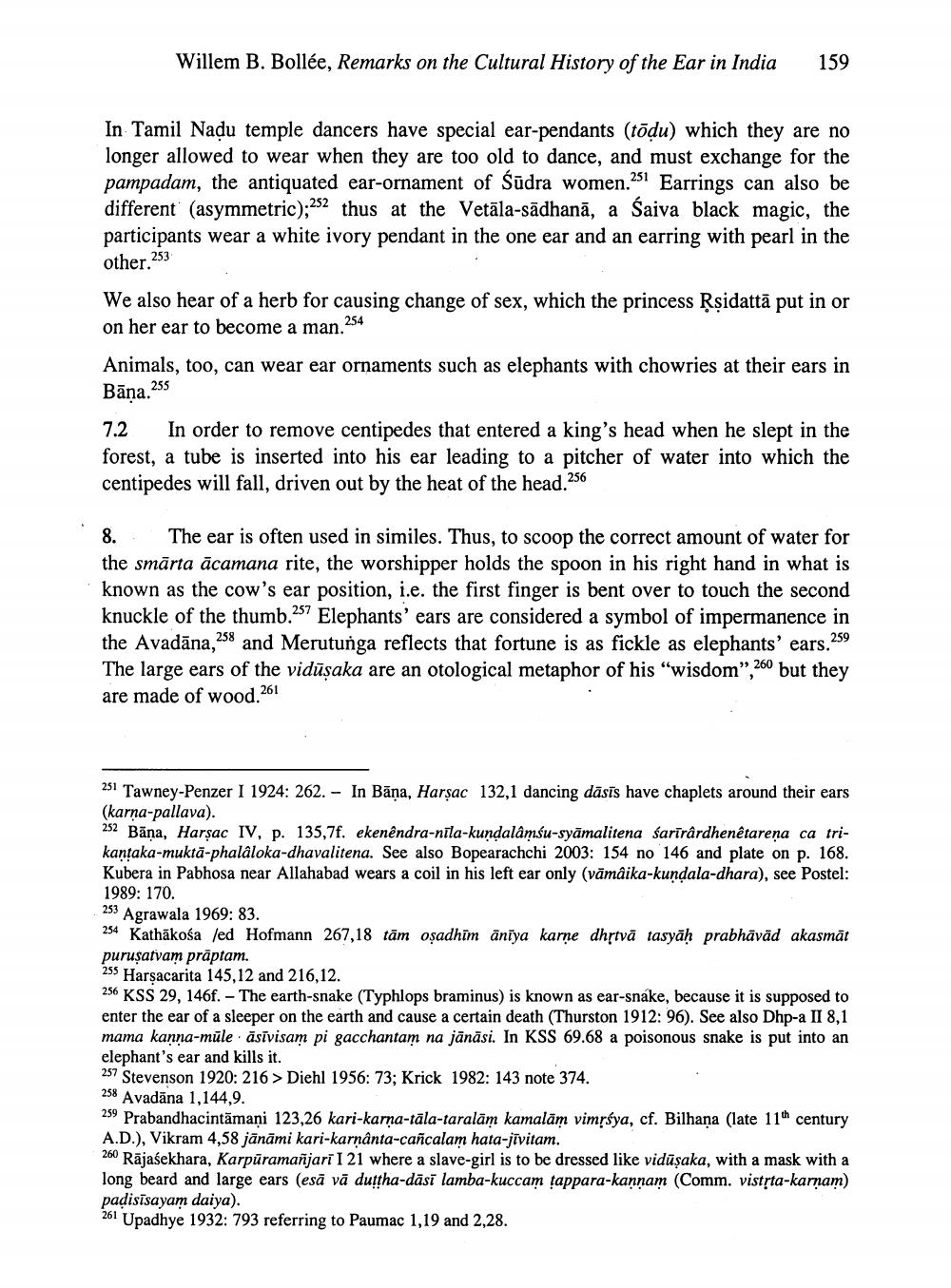________________
Willem B. Bollée, Remarks on the Cultural History of the Ear in India
159
In Tamil Nadu temple dancers have special ear-pendants (tōḍu) which they are no longer allowed to wear when they are too old to dance, and must exchange for the pampadam, the antiquated ear-ornament of Śüdra women.251 Earrings can also be different (asymmetric); 252 thus at the Vetäla-sädhana, a Śaiva black magic, the participants wear a white ivory pendant in the one ear and an earring with pearl in the other.253
We also hear of a herb for causing change of sex, which the princess Rṣidattă put in or on her ear to become a man.2
254
Animals, too, can wear ear ornaments such as elephants with chowries at their ears in Bāna.
255
7.2 In order to remove centipedes that entered a king's head when he slept in the forest, a tube is inserted into his ear leading to a pitcher of water into which the centipedes will fall, driven out by the heat of the head.256
8. The ear is often used in similes. Thus, to scoop the correct amount of water for the smarta ācamana rite, the worshipper holds the spoon in his right hand in what is known as the cow's ear position, i.e. the first finger is bent over to touch the second knuckle of the thumb. Elephants' ears are considered a symbol of impermanence in the Avadana, and Merutunga reflects that fortune is as fickle as elephants' ears.259 The large ears of the vidūṣaka are an otological metaphor of his "wisdom",260 but they are made of wood,261
257
258
251 Tawney-Penzer I 1924: 262. - In Bāṇa, Harṣac 132,1 dancing dāsīs have chaplets around their ears (karna-pallava).
252 Bāṇa, Harṣac IV, p. 135,7f. ekenêndra-nila-kundalâmsu-symalitena sarīrârdhenêtarena ca trikaṇṭaka-muktā-phalâloka-dhavalitena. See also Bopearachchi 2003: 154 no 146 and plate on p. 168. Kubera in Pabhosa near Allahabad wears a coil in his left ear only (vāmâika-kuṇḍala-dhara), see Postel: 1989: 170.
253
Agrawala 1969: 83.
254 Kathakosa /ed Hofmann 267,18 tām oṣadhīm ānīya karṇe dhṛtvā tasyāḥ prabhāvād akasmāt puruşatvam praptam.
255 Harṣacarita 145,12 and 216,12.
256 KSS 29, 146f. The earth-snake (Typhlops braminus) is known as ear-snake, because it is supposed to enter the ear of a sleeper on the earth and cause a certain death (Thurston 1912: 96). See also Dhp-a II 8,1 mama kanna-mule āsīvisam pi gacchantam na jānāsi. In KSS 69.68 a poisonous snake is put into an elephant's ear and kills it.
257 Stevenson 1920: 216 > Diehl 1956: 73; Krick 1982: 143 note 374.
258 Avadāna 1,144,9.
259 Prabandhacintämani 123,26 kari-karna-tala-taralam kamalām vimṛfya, cf. Bilhana (late 11 century A.D.), Vikram 4,58 jānāmi kari-karṇānta-cañcalam hata-jīvitam.
260 Rajasekhara, Karpūramañjarī I 21 where a slave-girl is to be dressed like vidūṣaka, with a mask with a long beard and large ears (esă vă duṭṭha-däsi lamba-kuccam tappara-kanṇam (Comm. vistṛta-karṇam) padisisayam daiya).
261 Upadhye 1932: 793 referring to Paumac 1,19 and 2,28.




